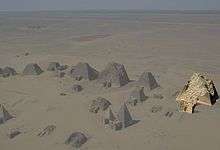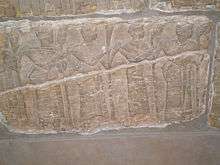Shanakdakhete
Shanakhdakheto or Shanakdakhete was a Queen of the Kingdom of Kush, when the polity was centered at Meroë. She is the earliest known ruling African queen of ancient Nubia,[1][2] and reigned from about 170 to 150 BC,[3] although the period 170–160 BC is also mentioned.[1] She is said to have ruled with full power in the Meroë Empire.[4] She is also said to have ruled without a king.[3] It is also stated that as queen she played a significant role in the Meroitic religion.[5] In the 2nd century BC Shanakdakheto built the Temple F at Naqa, which has an unusual feature in the first half of the temple with the interior partitions where the gods face the back wall.[6]
| Shanakdakheto | |||||
|---|---|---|---|---|---|
| Kandake of Kush | |||||
 Shanakdakheto statue (Cairo Museum) | |||||
| Reign | (ca. 170–160 BCE) or (ca. 170–150 BCE) | ||||
| Predecessor | Unknown Qore | ||||
| Successor | Tanyidamani | ||||
| Burial | ca. 160 BCE Pyramid at Meroë (Beg. N11) | ||||
| |||||
| Dynasty | Meroitic | ||||
Overview

Shanakdakheto's name is inscribed as a royal queen in the Egyptian Meroitic hieroglyphs. This inscription is the one seen on the doorjambs of the altar niche of Temple F in Naqa.[1] Shanakdakheto styled herself as: Son of Re, Lord of the Two Lands, Shanakdakheto (Sa Re nebtawy, Shanakdakheto).[7] The inscription reads:[1]
- "The royal-waab-priest of the Son of Re: Shanakdakheto given life every day 'beloved of Ma'at' like... ,
- The son of Re, ..the Lord of the Two Lands (Egypt): Shanakdakhete”.
Meroites scripted their own language in the early part of the second century BC (alphabetical script during the reign of Ergamenes[8]), the language is still not fully deciphered[2]) and its first epigraphic inscription is said to be of Queen Shannakdahane in the Temple F at Naqa.[9]
Even though her family antecedents remain obscure, in one of her carvings on a dorsal pillar she is shown adorned with an insignia of rank on the forehead and a crown, similar to the one worn by the reigning kings with decoration of a sun-disk and tall feathers. The garment decorating her, similar to that seen in Pharaonic art, like Uraeus, is drawn as a three-part royal costume. The necklace and her earrings have decoration of a goat head, a sacred animal of the god Amun used in Kushite decorative tradition which was popular in Nubia. The prince standing next to her, wearing a tunic draped around the left shoulder in Greek style, is shown with an ordinary band as a crown. The two figures are shown with their left foot forward. As an African beauty, the queen is shown with a strong build, and bejeweled, a trait indicating wealth, power and prosperity, and child bearing capacity.[4][1]
In the decorations of her mortuary chapel, the architectural features are highly artistic.[1] In one sunken relief the queen is depicted wearing an embellished garment and bejeweled, sitting on a royal seat shaped as lion, carrying a spear and palm branch in her right, with her left hand raised.[10]
A double cartouche found in Naqa is dated to a later part of the second century BC which is said to be the earliest epigraph in meroitic hieroglyphic.[11] However, the hieroglyphic cursive on the Queen's cartouche is called "classical" in style, not seen on the Jebel Barkal slab of Tanyidamani's cartouche who was considered Shanakdakhete's successor. Her pyramid was identified at Meroë, next to Tanyidamani's but not established as her name is not preserved.[12] In the tomb chapel reliefs of Queen Shanakdakhete the carvings show men holding arrows as a Meroitic burial custom.[13]

In the sandstone relief stele (pictured) displayed at the British Museum which is the part of the wall of the steep-sided pyramids of the cemetery at Meroe, it is believed that Queen Shanakdakhete is shown enthroned with a prince standing next to her under the protection of Isis with wings. Scenes of religious offerings, the queen's evaluation in front of Osiris, and a number of bearers lined in the front carrying gifts are depicted in the reliefs.[2]
References
- Harkless 2006, p. 146.
- "Red sandstone relief from the pyramid chapel of Queen Shanakdakhete". British Museum. Retrieved 25 September 2015.
- Broida 2005, pp. 1–2.
- "Statue of queen and prince of Meroë". UNESCO Organization. Retrieved 25 September 2015.
- Ifie 2002, p. 157.
- Wenig & Brooklyn Museum 1978, p. 100.
- László Török, The kingdom of Kush: handbook of the Napatan-Meroitic Civilization, 1997
- Hintze & Hintze 1968, p. 26.
- Fage 1979, p. 230.
- Krause 1986, p. 105.
- Voogt & Finkel 2010, p. 224.
- Voogt & Finkel 2010, pp. 224–25.
- Wenig 1999, p. 173.
Bibliography
- Broida, Marian (1 November 2005). Ancient Egyptians and Their Neighbors: An Activity Guide. Chicago Review Press. ISBN 978-1-61374-039-2.CS1 maint: ref=harv (link)
- Fage, J. D. (1 February 1979). The Cambridge History of Africa. Cambridge University Press. ISBN 978-0-521-21592-3.CS1 maint: ref=harv (link)
- Ifie, Egbe (2002). Papers in Honour of Tekena N. Tamuno, Professor Emeritus, at 70. Oputoru Books. ISBN 978-978-8014-08-9.CS1 maint: ref=harv (link)
- Harkless, Necia Desiree (30 August 2006). Nubian Pharaohs And Meroitic Kings: The Kingdom Of Kush. AuthorHouse. ISBN 978-1-4520-3063-0.CS1 maint: ref=harv (link)
- Hintze, Fritz; Hintze, Ursula (1968). Civilization of the Old Sudan: Kerma, Kush, Christian Nubia. Argonaut Incorporated.CS1 maint: ref=harv (link)
- Krause, Martin (1986). Nubische Studien. P. von Zabern. ISBN 978-3-8053-0878-6.CS1 maint: ref=harv (link)
- Voogt, Alexander J. de; Finkel, Irving L. (2010). The Idea of Writing: Play and Complexity. BRILL. ISBN 90-04-17446-X.CS1 maint: ref=harv (link)
- Wenig, Steffen (1999). Studien Zum Antiken Sudan: Akten Der 7. Internationalen Tagung Für Meroitische Forschungen Vom 14. Bis 19. September 1992 in Gosen/bei Berlin. Otto Harrassowitz Verlag. ISBN 978-3-447-04139-3.CS1 maint: ref=harv (link)
- Wenig, Steffen; Brooklyn Museum (1978). Africa in antiquity: the arts of ancient Nubia and the Sudan. Brooklyn Museum. ISBN 978-0-87273-065-6.CS1 maint: ref=harv (link)
Further reading
- Laszlo Török, in: Fontes Historiae Nubiorum, Vol. II, Bergen 1996, 660–662
External links
| Wikimedia Commons has media related to Shanakdakheto. |